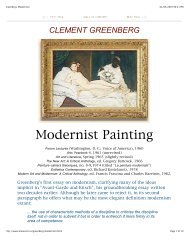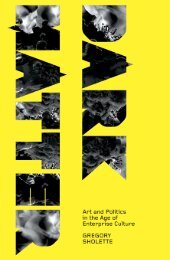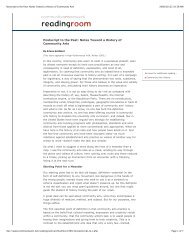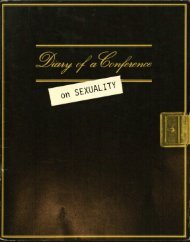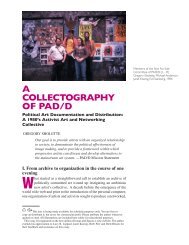Screen - Dark Matter Archives
Screen - Dark Matter Archives
Screen - Dark Matter Archives
Create successful ePaper yourself
Turn your PDF publications into a flip-book with our unique Google optimized e-Paper software.
82 insure itself against such labelling. Second, it produces a realblockage in the analysis and the production of representationsalike. A reticence about the portrayal of sexuality hovers overmuch British independent film production. I have felt a similarreticence in writing this ankle. Not only do definitions of pornographyhave an inhibiting moral force to them, but as a result oftheir blanket definitions. adequate means of writing and portrayalof sexuality have not been developed. Pornography is difficult todiscuss because there is no discourse which is analytic yet neverthelessengages the subjectivity of the individual uttering that discourse.We are caught between personal confessions and generaltheoretical systernatisations; mutually exclusive modes. each inadequateto the problems addressed.I have written this article to break through some of the problemsof 'pornography' by displacing the category itseU. Thisinvolves a double approach. There is a preliminary investigationof how 'pornography' is defined for us now. how a particular areaof signification is separated out across a wide range of media.Then, I have used a particular approach \,.,hich seems to be able todifferentiate between ki!lds of representations that are usuaUylumped togerber as 'pornographic-, and thus can offer a perspectivefor progressive work in this central and neglected area.Pornographic DefinitionsSexuality is never left unspoken in our culture: it is massivelypresent, but always subject to limirations. It is exhaustively definedacross a series of specialist discourses (medicine, psychiatry.criminology etc) but its more public manifestation is through allusionrather than description. Forms of humour, representations ofwomen, clothing and other diverse practices all invoke sexuality.But they cannot be said to describe or to define sexual practices:they indicate obsessively, pointing towards sexuality, but theynever differentiate, never show, never speak directly. Prohibitionsexist not upon speaking about sexuality. but an explicit descriptionsof sexual activities. Prohibitions exist upon representationswhich refer to sexual activity or display the human body in anovertly sexualised manner; on rhe public representation of sexualactivity and the circulation of such re presentations. The conjunc tion of sexual activity and representation. where the representationspecifies sexual activity rather than referring to it by inferenceor allusion, is the area of particular taboos and is the traditional area of pornography.An industry has developed to produce and market such proscribedrepresentations, ensuring their circulation outside thenorma l channels. This pornography industry is a reaction to thehistorically specific definitions of pornography, it is called intoexistence as a separate sector by campaigns and laws against 83pornography. Essentialist approaches to pornography as a particularkind of representation begin from the nature of the contemporatypornography industry and produce a definition of allthat industry's products. Such an approach ignores tbe conditionsof production of pornography as a proscribed area of signification.The various strong and specific definitions of pornographythemselves produce this area. and it is with them that investigationof the constitution of 'pornography' must begin if it is [Q beexamined in its specific existence at a particular historical moment.There will be no one unitary definition of 'pornography' butrather a struggle for predominance between several definitions.These definitions will work within a context defined by severalforces, the current form of the pornography industry and itsparticular attempts at legirimisarion; the partk ular form of thelaws relating to obscenity and censorship; and the general mobilisationof \'arious moral and philosophical positions and themesthat characterise a particular social moment. It is beyond thescope of this article to examine the articulation of such generalmoral and philosophical currents with the specific question ofpornography in the particular contemporary British attempts atdefiintion of the area. More immediate is the complex question ofthe legal forms which are currently in use in Britain. These areby no means easy to describe (the Williams report concludes that,here, in England and Wales at least, 'The law, in shan. is in amess' 2.29) , yet their effect s across various media are quitemarked . In addition, censorship is often undertaken by bodies ofno fo rmal legal standi ng like the British Board of Film Censors,wh ich exists as a convenient delegate and centraliser of localauthority film censorship powers. At every point, however. whetherin pre-censorship as with cinema, or prosecution after publicationas with printed material, both the law and its individual implementationsrely on contemporary morality and definitions of whatmight constitute permissible representations of sexual activity.The mid-nineteenth century test of whether 3 particular representationhas a tendency to 'deprave or corrupt' is used in most existinglegislation. This requires jurors to have a defi nite image ofwhat corruption and depravity might consist in their contemporaries:a definition which cannot but rely upon prevailing definitionsof 'pornography', its supposed erfects and its presumed socialrole.Legal action against representations of a sexual nature dependsupon the currem prevaiHng definition of pornography. Legalaction. or the possibility of it, in turn defines the nature of thepornography industry or institution. Representations becomeclandestine because they are threatened with prosecution; equally



